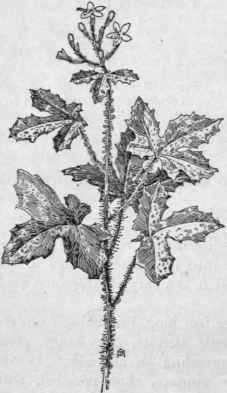Spurge Nettle Jatropha Stimulosa, Michx. Bull Nettle, Tread-softly
Description
This section is from the book "A Manual Of Weeds", by Ada E. Georgia. Also available from Amazon: A Manual Of Weeds.
Spurge Nettle Jatropha Stimulosa, Michx. Bull Nettle, Tread-softly
Native. Perennial. Propagates by seeds.
Time of bloom: May to September.
Seed-time: June to November.
Range: Virginia and Tennessee, south and west to Florida, Louisiana, and Texas.
Habitat: Prefers light, sandy soils, but invades nearly all crops.
The tough, woody, branching roots of this plant often penetrate the soil to a depth of three to five feet, taking to themselves what food and moisture is to be found. Herbaceous stems are sent up yearly, one to three feet tall, slender, branching, bright green, bristly with stinging hairs, which produce, when in contact with the skin, a much more painful and lasting irritation than do those of the nettle. The leaves are similarly armed; these are two to six inches or more broad, roundish heart-shaped in outline but three- to five-lobed, with prominent veins, wavy-toothed, and with prickly edges and long, bristly petioles. Male and female flowers are separate, the staminate ones usually in terminal clusters, the fertile ones in the axils just below. Calyx of the staminate flower white, fuzzy, the five lobes spread salver-shape, more than a half-inch broad, fragrant; fertile flowers also five-parted but smaller, soon followed by three-celled, three-seeded, wrinkled, and bristly-hairy pods, about three-fourths of an inch long when mature. Seeds obovoid, smooth, nearly a half-inch long, mottled, and caruncled. (Fig. 183.)

Fig. 183. - Spurge Nettle (Jatropha stimulosa). X 1/4.
Means Of Control
Cutting, again and again cutting, throughout the growing season, with a sharp steel hoe or a cultivator with broad and very sharp blades, in order to starve the roots and prevent all seed production.
Continue to:


